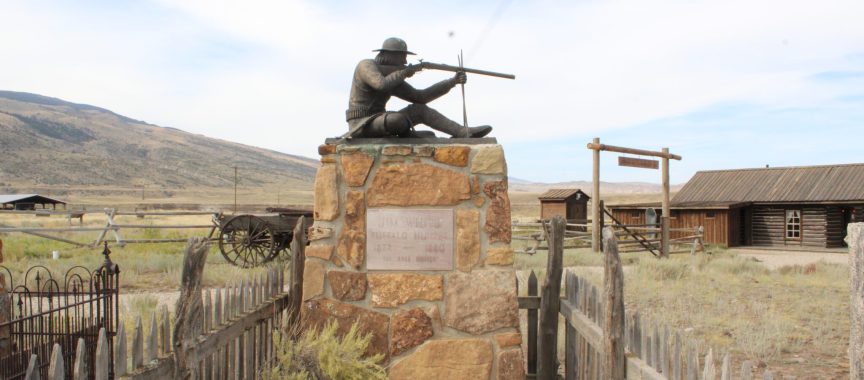News – Sheridan Media

Buffaloes, or American Bison, were once numerous across the Western Plains, including much of Wyoming. When Lewis and Clark came through what is now South Dakota in 1804, Lewis estimated one herd of buffalo to have around 3000 animals in it.
When civilization moved west, buffalo hunters came as well. This is their story.
The Wyoming Industrial Journal, August 1, 1899 Cheyenne – An Absent Pioneer -The plains, mountains and valleys of the Great West had been rounded up by all the cowboys of the country for the purpose of securing one buffalo for attendance upon Frontier Day this year, it is almost certain that not one of these noble animals would have been found. And yet scarcely thirty years ago General Sheridan reported nine million buffaloes on the prairies.
Buffalo Bill, who contributed as much as any individual to the extinction of the buffalo, says in the Philadelphia Evening Post that seemingly it was a pitiful waste of the natural resources of the country. “But,” he continued, “as I look back up on it, I see now that it was a sharp, quick way of ridding the plains of a cumbrance that had to give place to a wiser use of these fine grass lands. It was another instance of civilization getting what it wanted and never minding the cost. Civilization wanted the West, but it had no use for the Indian or the buffalo it found in possession of the West; and the Indian and the buffalo had to go, as all things go, before the relentless march of the white man.
Truer words were never spoken.
“We could not make a useful citizen of the Indian, and we could not run our brands on the buffalo, so now there are few Indians and no buffalo. Extravagant as may seem the slaughter, the country is as much better for it as cities are better than tepees, and cattle and sheep are better than buffaloes.

Photo take in Buffalo Bill Center of the West, Cody, Wyoming
“It is not yet hard to find men who can remember riding for days through mighty herds of buffaloes too contemptuous of us in their numbers to mind the crack of a rifle in the least. At night we had to place guards around our camps to prevent these great herds from trampling us out of existence. We found fresh herds in almost every direction, though each herd stayed pretty much on its own chosen range, wandering only a hundred miles or so here or there. “They chose the uplands for their ranges, where the crisp buffalo grass was plentiful and water good. They did not migrate in winter, but stubbornly faced the fiercest blizzards, relying for warmth on the hair matted thick about their shoulders. “While the buffalo was food and clothing and shelter for the Indians, the Indian played no considerable part in the extinction of the species.
“The buffalo is a slow breeder, the cows dropping calves only once in two or three years, but the arrows of the Indians never diminished their number. The Indians were bold riders and good hunters, but they killed only to satisfy their own immediate wants.”
The Indians depended upon the buffalo for food, as well as using the other parts of the buffalo. Hides were used for tepees walls, bull boats, clothing and moccasins. Sinews were used as thread, horn sheaths were used as spoons, ladles and drinking cups; skulls were used in many rituals, such as the Sundance.
“Nor did the herds suffer greatly from the rifles of the early trappers and scouts who conducted wagon trains across the plains to California. These men were famous shots, and hunted on horseback in bold dashes on the herds, as the Indians hunted, but they had no way of reaching a market with hides and meat, and killed only to supply the needs of the parties they were conducting.
“After the civil war, when Uncle Sam began to multiply his posts in the great West, some of the best of these plains men became hunters for the Government, and buffalo meat was an important part in army rations. We began to use breech-loaders about that time, and the buffaloes fell faster. I still have an old .48 Springfield which I used when hunting for the Government, and I suppose I must have killed 15,000 buffaloes with it.
“But it was the whistling of locomotives crawling farther and farther along the Plains that sounded the doom of the buffalo. Even before the railroads were finished the real attack on the herds began. The railroad builders found this supply of fresh meat very convenient for feeding construction gangs, and good buffalo hunters, who were not afraid to face the hostile Indians who hovered about, were in great demand. In 1867 I began killing buffaloes for the Kansas Pacific, and shot nearly 5,000 of them to feed the laborers who were building that line. It was from them that I first got the name of Buffalo Bill. For a long time this road, which afterwards became the Union Pacific, used buffalo heads as an advertisement, and I used to save for this purpose the handsomest heads I killed.

“It was when the railroads got in operation on the Plains that an army of hide-hunters appeared and sealed the fate of the buffalo. They were a strange class of men, developed by the peculiar cir circumstances of their trade, and they disappeared with the buffalo. They flourished in the ten years between 1870 and 1880, during which time they completely exterminated the herds. Buffalo hides, dried green, brought $3 apiece, summer and winter alike. The skins were used not so much for robes as for leather of a somewhat inferior grade.
“Ten or twelve men, with several wagons, made up a hide outfit. They set out from some railroad point, got among a herd, and camped on their trail day after day until they had wiped out the whole herd. From time to time they sent back wagon loads of hides to the railroad and shipped them to eastern tanneries. The best men in these outfits were the hunters, who used heavy Sharp’s rifles and stalked their game on foot. The rest of the men were skinners, who followed the hunters, stripped off the hides of the victims, and left the meat to rot. “Now the bone-pickers appeared on the scene. The vast herds no longer thundered over the Plains, but millions of skeletons lay bleaching in the western sun. The bone-pickers diverged from various railroad points with wagon trains and, following the routes of the hide-hunters, loaded their wagons with the bones of the buffaloes where the hunters had slain them.
“These bones were carted back to the railroads and shipped east, so the buffalo be came commercial fertilizer. Great ricks of bones, piled higher than a house, appeared by the sides of the railroads, and long lines of box cars heaped with bones crawled east over the Plains. This was the funeral cortege of the buffalo. “All this while great herds of cattle were being driven north over the trails from Texas and Mexico, and rapidly increasing, filled the ranges which had been cleared for them by the slaughter of the buffalo.
“Now came another class of men, quite as picturesque as the other early types of the Plains. These were the cowboys; rude and tough, and reckless, and manly, and brave, leading lives full of hardships and perils and grit. They were better men than the hide-hunters and the bone-pickers, whose places they took. Civilization had cleared the ground of the buffalo to make room for cattle. “Possibly far north in the heavily timbered wilds of British Columbia a few mountain buffalo may live in timid seclusion, soon to vanish.
“Personally I saw the last of the buffalo in a lonely valley in northwestern Wyoming many years ago. Riding one morning over a divide I looked down into the little valley, peaceful and quiet, and very still. The rising sun shone down upon three thousand skeletons, gleaming white in the grass, eloquent of the passing of the mighty hosts of buffalo.”
According to the Wyoming Commonwealth, Cheyenne, on September 21, 1890, another buffalo hunt took place in Wyoming, but not to kill them, but to capture them. One could only imagine what a circus that would be.
A Buffalo Hunt on the Red Desert —A Novel Wyoming Experience. Search For the Only Herd of Bison Not in Captivity—They Will be Lassoed and Brought to Laramie
It is generally supposed that the American bison has about disappeared from the face of the earth and it is every now and then announced through the press that the last herd has been corralled either in Texas or Manitoba, but it appears that there still exists a small herd in Wyoming, for whose capture a well equipped party left Laramie this morning.
The party consists of J. C. Rob bins, Jack Hills, John Woodruff and Frank Kelley, who are accompanied by a couple of the most expert lassoers in the country. Their object is not to slaughter the herd, but to lasso them and bring them alive to Laramie.
The herd has been seen by several different parties during the past year and its haunts pretty well located. It is supposed to be now located on Red Desert and that is the objective point of the Laramie buffalo hunters. The latter take with them a grub wagon and ten saddle horses, and expect to be absent four months. If at the end of that time they should return with a half dozen or more buffalo, they will have a property nearly as valuable as a gold mine, and will in all probability start a buffalo ranch on the Laramie plains, after the style of that owned by Hon. C. J. Jones, at Garden City, Kansas.
“Buffalo” Jones, as he is familiarly known, has a very large ranch at Garden City, on which he has some 200 head of full-blooded and graded bison. He has made a great success at breeding them with native cattle, and finds that the result thus obtained is in many respects a superior animal to the bison, the robe, particularly, being of a lovely seal brown and as fine as a genuine sealskin.
Jones has been trying to get hold of all the buffalo left on this continent, and two years ago purchased the famous herd owned by a party near Winnipeg, paying a very large price for them. The only other herd known to exist in this country is one at Bismarck Grove, Kan., numbering fifteen, and owned by Col. H. H. Stanton, of Kansas City.
They are not for sale at any price. One bull in the herd, named Cleveland, is said to be the finest living specimen of a race now almost extinct. These cases are mentioned to show the importance of the expedition now on its way to Red Desert, should its object be accomplished. That the capture of the herd is feasible is shown by the fact that a few months ago a cowboy who ran across them lassoed one, threw it and branded it, after which he turned it loose, the state law making it a penitentiary offense to kill a buffalo
The difficulty the party will encounter will be not so much to capture this noble game as to get them to Laramie after they are taken, as they are the most stubborn and intractable brutes on earth. It is probable that they will be taken to the nearest railroad station and shipped on the cars to this point. There is scarcely a doubt that this will be the last buffalo hunt enjoyed by any party in the United States—it certainly will be the last in Wyoming, and if through its means the species can be increased and perpetuated the expedition will not have been undertaken in vain. A full-blooded American bison is worth from $300 to $3,000, where they can be bought at all. -Laramie Republican

Today, bison live in private ranches, and in herds on national and state park lands, such as Yellowstone and Custer State Park in South Dakota. Thanks to farsighted men, such as the ones in the above article, the buffalo has made a come back.
Featured Image, Old Trail Town, Cody, Wyoming. Buffalo photos taken in Custer State Park, Custer, SD.
Last modified: October 6, 2025






